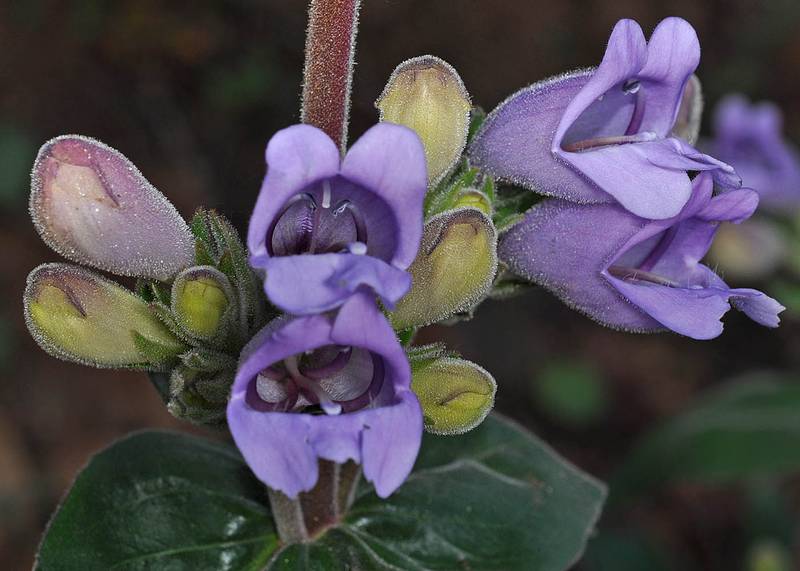|
glandular penstemon
|
Barrett's beardtongue
|
| Stout perennial herb from a branched, woody base, the several stems 4-10 dm. tall, sticky throughout with stalked glands. |
Perennial, the lower part shrubby and branched, the stems 2-4 dm. tall; herbage and inflorescence glabrous and glaucous. |
Leaves opposite, sharply toothed or entire, the basal ones 10-35 cm. long and 2.5-9 cm. wide, petiolate, the blade lanceolate to elliptic; lowermost cauline leaves reduced, the others well-developed, sessile and often clasping, broadly lanceolate to rotund-ovate, 4-12 cm. long and 2-5 cm. wide. |
Leaves opposite, firm, irregularly serrulate or entire, the larger ones, up to 8 cm. long and 2.5 cm. wide, on sterile shoots borne toward the base of the main stem; cauline leaves broad, sessile, and clasping, 1.5-3.5 cm. long and 0.8-2 cm. wide |
Inflorescence of several verticillasters; calyx 9-15 mm. long, the 5 segments narrow and herbaceous; corolla blue-lavender, strongly glandular-hairy outside, glabrous inside, 28-40 mm. long, over 1 cm. wide at the mouth; anthers permanently horseshoe-shaped, 1.7-2.3 mm. long; pollen sacs dehiscent across their apices, the lower part saccate and indehiscent, glabrous; staminode glabrous, the tip flattened. |
Inflorescence essentially a raceme, the axillary peduncles simple and single-flowered or sometimes branched and 2-flowered; calyx 5-7 mm. long, the 5 segments thin, ovate; corolla bilabiate, lilac or rose-purple, 33-38 mm. long, 1 cm. wide at the mouth, glabrous outside, long-hairy near the base of the lower lip within; anthers densely long-woolly, pollen sacs wholly dehiscent, becoming opposite |
Capsules 10-14 mm. long, surpassed by the calyx. |
Capsule narrow, up to 1 cm. long. |
|
|
|
|
| May-July |
April-May |
| Open, often rocky hillsides and banks in the foothills, valleys, and lower mountains. |
Woodland openings and rocky slopes at low elevations. |
Occurring east of the Cascades crest in Washington; central Washington to north-central Oregon, and from southeastern Washington to eastern Oregon, east to Idaho.
|
Occurring in the east end of the Columbia River Gorge in Washington; south-central Washington to adjacent north-central Oregon.
|
| Native |
Native |
| Not of concern |
Threatened in Washington (WANHP) |
P. acuminatus, P. attenuatus, P. barrettiae, P. cardwellii, P. cinereus, P. confertus, P. davidsonii, P. deustus, P. ellipticus, P. eriantherus, P. euglaucus, P. fruticosus, P. gairdneri, P. hesperius, P. lyallii, P. ovatus, P. palmeri, P. pennellianus, P. procerus, P. pruinosus, P. richardsonii, P. rupicola, P. rydbergii, P. serrulatus, P. speciosus, P. subserratus, P. triphyllus, P. venustus, P. washingtonensis, P. wilcoxii |
P. acuminatus, P. attenuatus, P. cardwellii, P. cinereus, P. confertus, P. davidsonii, P. deustus, P. ellipticus, P. eriantherus, P. euglaucus, P. fruticosus, P. gairdneri, P. glandulosus, P. hesperius, P. lyallii, P. ovatus, P. palmeri, P. pennellianus, P. procerus, P. pruinosus, P. richardsonii, P. rupicola, P. rydbergii, P. serrulatus, P. speciosus, P. subserratus, P. triphyllus, P. venustus, P. washingtonensis, P. wilcoxii |
|
|
| |



